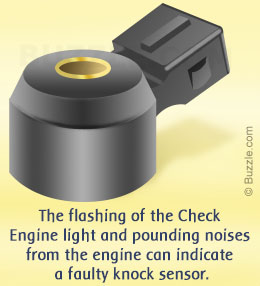
Quick TipMost knock sensors look the same. However, since the part is matched to the PCM and the engine, you must fix an appropriate sensor depending on the type of vehicle. Not doing so will result in the sensor reacting to even the regular vibrations of the engine, causing faulty readings.All modern automobile engines have numerous sensors attached to it, which help in performing a many functions such as the shifting of gears, timing the ignition, controlling fuel and emissions, etc. The knock sensor is a listening device, usually located on the engine block, that studies the sounds generated by the engine, detects detonations/explosions caused by fuel in the cylinders, and adjusts the ignition timing appropriately.
If the knock sensor is malfunctioning, such detonations cannot be monitored, which will not allow the engine to run smoothly due to improper ignition timing. This will eventually cause damage the components. Usually, such symptoms clearly show up at high speeds or when the vehicle is carrying heavy loads. Ideally, one should compare the performance of the engine to the specifications mentioned in the instruction manual of the vehicle. Learning to recognize the symptoms of a bad knock sensor, and replacing it in a timely manner, will prevent a hefty repair bill.
Bad Knock Sensor Symptoms
- The most common symptom of a failed knock sensor is the flashing of the ‘Check Engine’ light on the console or dashboard of the car. However, sounds generated by the combustion of bad gasoline can also trigger the knock sensor. You need to fill the car with high grade gasoline. If the light is still flashing, you need to get the sensor checked by a mechanic.
- Improper combustion of fuel and air can cause the knock sensor to malfunction. You can normally detect this when you hear clunking, thumping, or sputtering noises coming from the engine, which gradually increase in intensity over time.
- Another symptom of a faulty knock sensor is the misfiring of the engine on starting, accompanied by unusual vibrations throughout the vehicle.
- Knock sensor failure is often followed by a significant drop in the fuel economy of the vehicle.
- Burning fuel and exhaust smells emanate from the engine area.
- In case of a knock sensor problem, the car may exhibit certain signs such as slowed acceleration, and dragging or jerking sensations while trying to step on the gas.
- If you see corresponding light codes such as P0325 or P0330 from the user manual, it could either signify a misfire in the engine cylinders or the failure of the knock sensor.
How to Test a Knock Sensor
- Find the electric harness above the thermostat (usually located near the area where the radiator hoses meet the engine). It is usually a gray/black connector with two wires and a red cap.
- Unplug this connector and fix a voltmeter that can measure more than 10 M ohms to the male connector.
- Check the foremost terminal and ground the negative point out.
- Check the voltmeter for continuity after turning the vehicle on. If there is a problem with this, you will need to replace the knock sensor.
- Also, if your vehicle has run over 100,000 miles without replacing the knock sensor, it is best to get it changed.
- You will also need to check for frayed wires to confirm a faulty sensor.
- Another way to test the knock sensor is by striking the intake manifold above the knock sensor with a wrench, while the engine is running. Be careful not to strike the sensor. Hitting the intake manifold should result in a small change in the sound of the engine. If this does not occur your knock sensor is probably dead.
While replacing the knock sensor, you will need to open the intake manifolds, which will give you an opportunity to service other parts such as valve cover gaskets, spark plugs, coolant hoses, coolant passage plates, etc. Watching out for the above mentioned symptoms will keep your vehicle running smoothly for many years to come.